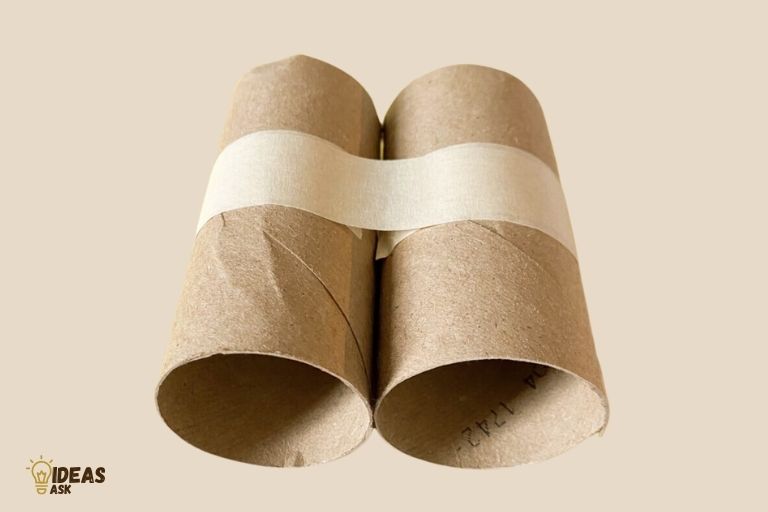How to Make Binoculars Out of Paper Towel Rolls? 8 Steps
To make binoculars out of paper towel rolls, collect two empty rolls, some colored paper, a piece of yarn, glue, and scissors.
Begin by cutting the paper to fit around the rolls. Apply glue to the paper and wrap it around the rolls, securing them together.
After the glue dries, poke two holes in the ends of the rolls and thread the yarn through to create a handy neck strap.
This craft project is a fun and simple way to upcycle paper towel rolls. Children can be creative with their designs, using their favorite colors or adding stickers and drawings.
Making binoculars from paper towel rolls is a fun and educational activity.
Children can learn about recycling and repurposing items, while also engaging with their natural environment. Moreover, they can personalize their binoculars, fostering their creativity and artistic skills.
To finish, these homemade binoculars are perfect for pretend play or even real-life bird watching, opening up a whole new world for little explorers to discover.
8 Steps for Making a Binoculars Out of Paper Towel Rolls
| Step No. | Instructions |
|---|---|
| 1 | Gather all necessary materials: two paper towel rolls, string, scissors, glue, hole puncher, duct tape. |
| 2 | Using the scissors, cut a 1-inch circle at the end of each paper towel roll. |
| 3 | In the same end, punch out two small holes with the hole puncher. The holes should be on opposite sides of the roll. |
| 4 | Cut a piece of string about twice as long as one paper towel roll. |
| 5 | Push one end of the string through a hole on one roll, and the other end through the corresponding hole on the other roll. Knot the ends of the string to secure the rolls together. |
| 6 | Apply some glue around the edge of the 1-inch circle of one roll, then press the roll against the other one, sticking them together. |
| 7 | Secure the connection with duct tape. Wrap it around where the two paper towel rolls meet. |
| 8 | Allow the binoculars to dry before using. |
Key Takeaway

Five Facts About Making Binoculars with Paper Towel Rolls
Step-By-Step Guide To Making Binoculars Out Of Paper Towel Rolls
Are you looking for a fun diy project to keep you or your kids entertained? Why not try making your own binoculars out of paper towel rolls?
Not only is it an enjoyable way to pass the time, but it’s also an opportunity to teach children about the importance of recycling and repurposing everyday items.
Here’s a step-by-step guide on how to create your own binoculars using only paper towel rolls, tape, and lenses.
Explain How To Prepare The Materials Before Starting The Project
Before you get started, gather all your materials in one place. You’ll need two paper towel rolls, a pair of lenses (can be found online or in a hardware store), scissors, and tape.
Make sure that each paper towel roll is clean and dry, with no leftover residue from the paper towels.
List Down The Step-By-Step Instructions In Detail
- Cut each paper towel roll in half, lengthwise.
- Take one of the halves and cut it down the middle so you have two equal-sized pieces.
- Roll one of the smaller paper towel pieces tightly, making sure it remains a cylinder shape.
- Insert the rolled paper towel into the longer paper towel roll. Repeat this step with the second paper towel roll so that you have two rolls with a smaller, rolled paper towel inside.
- Attach the lenses to each end of the paper towel rolls with tape, making sure they are secure. Use two small pieces of tape to hold each lens in place.
- Adjust the distance between the lenses by sliding the rolled paper towels in or out, until you achieve the desired focus.
- You can decorate your binoculars with paint, stickers or markers to make them look more personalized.
How To Cut The Paper Towel Rolls?
Cutting the paper towel rolls is easy, and you only need a pair of scissors. Cut each paper towel roll in half first, lengthwise. Then take one of the halves and cut it down the middle so you have two equal-sized pieces.
How To Attach The Lenses With The Help Of Tape?
Using tape to attach the lenses to the paper towel rolls is simple, but you want to make sure that they are secure.
First, position the lens over one end of the roll. Second, use two small pieces of tape to hold the lens in place. Third, repeat this step with the second lens on the other end of the paper towel roll.
How To Align The Rolls And Test The Binoculars?
Once you have the lenses attached, you need to adjust the distance between the lenses by sliding the rolled paper towels inside the longer paper towel rolls.
This will require some experimentation to find the right distance between the lenses that will allow you to focus on objects in the distance.
Once aligned, test the binoculars by looking through them and making minor adjustments until you can see objects clearly.
Congratulations! You have now made a pair of binoculars from paper towel rolls and learned a valuable lesson on the importance of recycling. Enjoy your new creation and use it to observe the world around you.
Tips And Tricks For Making The Perfect Binoculars Out Of Paper Towel Rolls
Making binoculars out of paper towel rolls is an enjoyable craft activity for all ages.
Not only is it a fun way to pass the time, but it also helps to develop fine motor skills, creativity, and imagination. However, to achieve the perfect paper towel roll binoculars, there are some tips and tricks to follow.
Discuss Some Common Mistakes That Beginners Make While Making Binoculars Out Of Paper Towel Rolls
When making binoculars out of paper towel rolls, beginners tend to make the following mistakes:
- Using low-quality materials that result in easily torn or broken binoculars
- Not securing the lenses or covering them properly
- Creating uneven holes for the lenses, which affects the perception and focus
- Failing to evenly cut the paper towel rolls to match their length
- Not gluing or taping the two rolls together strongly enough, causing the binoculars to fall apart quickly.
Suggest Some Creative Ways To Decorate And Personalize The Binoculars
There are many ways to decorate and personalize paper towel roll binoculars.
Here are a few creative ideas:
- Use colorful washi tape to cover the binoculars, adding a pop of color and pattern
- Draw various designs or shapes onto the surface of the paper towel rolls
- Add stickers or glitter to create a fun and sparkling appearance
- Cut out animal or nature images and glue them to the binoculars surfaces
Give Tips On How To Make The Binoculars More Durable And Lasting
To make the binoculars more durable and lasting, consider the following tips:
- Use thicker paper towel rolls or cardboard instead of regular paper towel rolls.
- Ensure that the glue or tape used to hold the binoculars together is strong, secure, and evenly applied.
- Cover the binoculars with a layer of clear protective sealant to prevent wear and tear, moisture, and other environmental factors.
- Add extra reinforcement to the lenses or outer parts that are more susceptible to breakage or wearing down.
By following these tips and tricks for making paper towel roll binoculars, you can enjoy a fun and educational activity that results in a successful and personalized craft project.
Fun Activities To Do With Your Binoculars
How to make binoculars out of paper towel rolls: fun activities to do with your binoculars
Binoculars can provide an excellent opportunity for kids to explore and learn about the world around them, all while having fun.
Here are some exciting activities you can do with your diy binoculars made from paper towel rolls:
List Down A Few Ideas For Adventurous Activities With Binoculars
- Scavenger hunt – create a list of things found in nature, such as flowers, leaves, and rocks. Have kids use their binoculars to find those items.
- Stargazing – use binoculars to explore the night sky and gaze at stars, planets, and the moon.
- Nature exploration – take a hike and use your binoculars to spot birds, insects, and other wildlife in their natural habitat.
Exploring Nature
Using binoculars is an excellent way to explore and appreciate the natural environment.
Here are some ideas for exploring nature with binoculars:
- Observe different types of trees, leaves, and flowers in a local park or forest.
- Take a closer look at bodies of water, such as rivers, streams, and lakes, and observe the animals and plants that live in them.
- Identify different types of birds in your garden or local park.
Bird-Watching
Binoculars offer a great way to observe birds up close, and bird-watching is an excellent activity for kids of all ages.
Here are some tips for successful bird-watching adventures:
- The earlier, the better – birds are most active in the early morning, so this is the best time for bird-watching.
- Look for habitats – birds are most frequently seen in their natural habitats, such as woodland or water environments.
- Use a bird guide – identify different bird species using a bird guide, which can be found online, in libraries, or purchased from a store.
Spy Games
Using binoculars for spy games can provide hours of entertainment and foster teamwork and social interaction among kids.
Here are some spy game ideas:
- Create secret messages or codes that kids can use to communicate with each other while spying.
- Play hide-and-seek or capture the flag with binoculars as the spying tool.
- Take turns being a “spy” and giving clues on what they can see through the binoculars while others guess what they are spying on.
Discuss How Binoculars Can Enhance The Learning Process For Kids
Binoculars can enhance the learning process in many ways, such as:
- Developing observation skills – using binoculars encourages kids to look closely at the world around them and develop their observation skills.
- Learning about the environment – through binoculars, kids can learn about different habitats and ecosystems.
- Improving vocabulary – through bird-watching, kids can learn about different bird species, their behaviors, and their habitats.
Outline How Binoculars Can Promote Teamwork And Social Interaction
Binoculars can promote teamwork and social interaction in many ways, such as:
- Working together to identify different birds or animals.
- Taking turns with the binoculars during scavenger hunts or spy games.
- Communicating with each other while on nature hikes or exploring new environments.
Diy binoculars made from paper towel rolls offer a unique opportunity to engage kids in fun and adventurous activities while promoting teamwork, social interaction, and learning.
Use them to inspire curiosity about the world around us and help kids develop their observation skills.
FAQ On Making Binoculars Out Of Paper Towel Rolls
What Materials Do I Need To Make Binoculars Out Of Paper Towel Rolls?
To make binoculars out of paper towel rolls, you’ll need two paper towel rolls, scissors, tape, glue, and decorative materials.
How Do I Prepare The Paper Towel Rolls For Binoculars?
Cut two small rectangular pieces of paper and glue them over one end of each paper towel roll. Then, tape the two rolls together, side by side.
Can I Decorate My Paper Towel Roll Binoculars?
Yes! You can decorate your paper towel roll binoculars with markers, stickers, or any other craft materials you have at home.
Can I Make Binoculars Out Of Other Materials Besides Paper Towel Rolls?
Yes! You can make binoculars out of cardboard tubes, pvc pipe, or even toilet paper rolls. Just make sure they’re the right size and shape.
Conclusion
Crafting a pair of binoculars out of paper towel rolls is a simple yet fun activity for children and adults alike. It is a great way to get creative while also exploring the world around us.
The materials needed are inexpensive and easy to find, making it an accessible project for all. By following the step-by-step instructions outlined in this guide, anyone can create their own binoculars in just a few minutes.
Not only is this a fun craft project, but it also encourages us to look at our environment in a different way. Instead of just glancing around, we can use our new binoculars to zoom in and appreciate the details that might have gone unnoticed before.
So go ahead and grab those paper towel rolls and start creating your own set of binoculars – the possibilities for exploration are endless!





